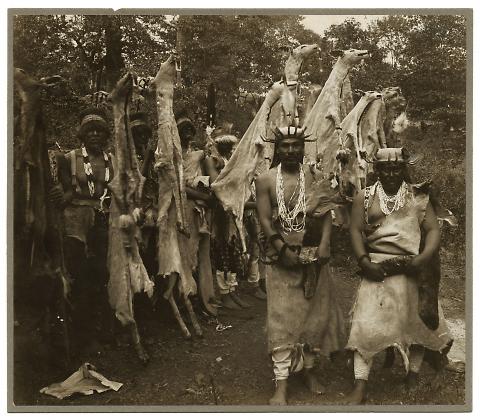H16.1131E
(17.14 cm HIGH x 19.84 cm WIDE)
Photographs of Indian life. "White deer skin dance, Hupa Tribe, Athapascan family, no. cailf." info from the OMCA green/blue "cross-file record of pictures" paper found in the museum. Image is of the White deerskin dance, two men at the right forefront of the photo and a diagonial line of men behind them. Photo is mounted on a grey board. (TKP 11/16/2010) According to Humbolt State University, Special Collection Department of the Library who has a large Ericson collection, this image is "Along the "Redwood Highway" White Deerskin Dance, Klamath, Cal. #11/Among the Indians in California [White Deer Skin Dance - 1899 - Hoopa #1 "Masters of Ceremony"/unknown] ." This information was accessed 11/17/2010 by TKP from the California tal Library run by the University of California. Susana Macarron found a copy of this photo from the Smithsonian Institution in a folder at the CCRC on 11/18/2010 where the image is identified as "beginning of whtie deerskin dance. Chiefs in front carry sacred obsidian knives. By A.W. ericson, eight miles from Yurok town of Weitchpec, Humboldt County, California, ca. 1890-1987. Tribe: Hupa (California). Neg. No. 43,114-a." (11/17/2010 TKP)
Picture This Information
This artifact is part of the OMCA's Picture This website. More about the context and history of this artifact is available at Picture This.
About the Picture This web project: California's Perspectives on American History is a resource for teachers and students to learn about the experiences of diverse peoples of California by using primary source images from the Oakland Museum of California's collections. Organized into 11 time periods spanning from pre-1769 to the present, more than 300 photographs, drawings, posters, and prints tell stories from the perspectives of different ethnic groups. Historical contexts are provided to offer a framework of California's role in relation to American history.
The National Archives state that primary sources, "fascinate students because they are real and they are personal: history is humanized through them." Picture This invites students to examine the historical record, encouraging them to connect history with real people and explore how images tell stories and convey historical evidence about the human experience. History becomes more than just a series of facts, dates, and events.


